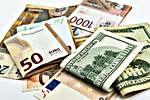
This report focuses on currency exchange rates starting with the buying power of one US dollar in relation to the specific foreign currencies of the 25 wealthiest economies.
According to The Economist, all economic policies impact exchange rates. However, changes in a country’s interest rates have probably the most direct and visible effect on a currency’s comparative strength versus the world reserve currency, the US dollar.
The most immediate effect from a weakening currency versus the US dollar is higher domestic inflation due to the resulting more expensive imports. In addition, exports converted from a depreciating foreign currency to US dollars generate less income in US dollar terms. The foreign country’s trade balance deteriorates since it pays out more in its weakened currency to pay for imports in stronger US dollars but generates less money in American currency since fewer US dollars will buy more.
Opposite effects happen with when a foreign currency appreciates versus US dollars, nurturing trade surpluses for the trading nation with the stronger foreign exchange.
Richest Countries’ Currency Exchange Rates: November 2020
The table below shows the home country perspective for richest country exchange rates as of November 26, 2020. The domestic exchange rate identified shows the foreign currency amount required to buy one US dollar.
US dollars represent the only legal tender strong enough to be the benchmark for currency exchange rates globally.
Shown are changes in the strength of each currency from 2019 to 2020. Also identified is each country’s currency conversion structure defining how each wealthy nation calculates its exchange rates vis-à-vis the US dollar.
For example, the value of the Chinese yuan versus one US dollar is set using a monetary aggregate target. America’s largest trading partner Canada calculates its currency exchange on a free-floating basis, as does Mexico, Australia, Russia, Japan and the United Kingdom as well as European Union members that use the euro.
You can change the presentation order by clicking the triangle icons at the top of each column. Starting with the largest economy, the Rank column refers to the relative size of each country in terms of Gross Domestic Product (GDP) on a Purchasing Power Parity basis.
| Rank | Country | Currency | US$2020 | 2019-20 | Exchange Rate Regime |
|---|---|---|---|---|---|
| 1 | China | yuan | 6.908 | -4.8% | monetary aggregate target |
| 2 | United States | dollar | 1 | 0.0% | global anchor |
| 3 | India | rupee | 70.42 | 5.1% | floating |
| 4 | Japan | yen | 109.01 | -4.1% | free floating |
| 5 | Germany | euro | 0.893 | 33.1% | free floating |
| 6 | Russia | ruble | 64.738 | 16.6% | free floating |
| 7 | Indonesia | rupiah | 14,148 | -0.1% | floating |
| 8 | Brazil | real | 3.927 | 36.2% | floating |
| 9 | United Kingdom | pound | 0.783 | 70.1% | free floating |
| 10 | France | euro | 0.893 | 33.1% | free floating |
| 11 | Mexico | peso | 19.264 | 4.1% | free floating |
| 12 | Italy | euro | 0.893 | 33.1% | free floating |
| 13 | Turkey | lira | 5.674 | 38.8% | floating |
| 14 | South Korea | won | 1,165 | -4.7% | floating |
| 15 | Spain | euro | 0.893 | 33.1% | free floating |
| 16 | Canada | dollar | 1.327 | -1.8% | free floating |
| 17 | Saudi Arabia | riyal | 3.75 | 0.0% | conventional peg |
| 18 | Iran | rial | 42,000 | 0.3% | composite exchange rate anchor |
| 19 | Thailand | baht | 31.05 | -2.2% | floating |
| 20 | Australia | dollar | 1.439 | -5.6% | free floating |
| 21 | Poland | złoty | 3.839 | -2.2% | free floating |
| 22 | Pakistan | rupee | 150.036 | 6.1% | other managed arrangement |
| 23 | Malaysia | ringgit | 4.142 | -1.3% | other managed arrangement |
| 24 | Philippines | peso | 48.148 | 0.1% | floating |
| 25 | Netherlands | euro | 0.893 | 33.1% | free floating |
The greatest gains in currency value against the US dollar were for the British pound (up 70.1% from the 2019 average), Turkish lira (up 38.8%), Brazilian real (up 36.2%) then the euro (up 33.1%).
Slippages against the US dollar year over year range from -0.1% for the Indonesian rupiah and -1.3% for the Malaysian ringgit up to -4.8% for the Chinese yuan and -5.6% for the Australian dollar.
Richest Countries’ Currency Exchange Rates: Historical
Presented below are the average exchange rates against the US dollar derived from daily data for 2008, 2018 and 2019. Again, the focus is on 25 of the world’s richest countries and for which historical currency exchange rates were available from the IMF or the Organisation for Economic Co-operation and Development.
| Rank | Country | Currency | US$2019 | 2018 | 2008 | 2008-19 | 2018-9 |
|---|---|---|---|---|---|---|---|
| 1 | China | yuan | 6.908 | 6.616 | 6.949 | -0.6% | 4.4% |
| 2 | United States | dollar | 1 | 1 | 1 | n/a | n/a |
| 3 | India | rupee | 70.42 | 68.389 | 43.505 | 61.9% | 3.0% |
| 4 | Japan | yen | 109.01 | 110.423 | 103.359 | 5.5% | -1.3% |
| 5 | Germany | euro | 0.893 | 0.847 | 0.68 | 31.4% | 5.5% |
| 6 | Russia | ruble | 64.738 | 62.668 | 24.853 | 160.5% | 3.3% |
| 7 | Indonesia | rupiah | 14,148 | 14,237 | 9,699 | 45.9% | -0.6% |
| 8 | Brazil | real | 3.927 | 3.654 | 1.834 | 114.2% | 7.5% |
| 9 | United Kingdom | pound | 0.783 | 0.75 | 0.544 | 44.0% | 4.5% |
| 10 | France | euro | 0.893 | 0.847 | 0.68 | 31.4% | 5.5% |
| 11 | Mexico | peso | 19.264 | 19.244 | 11.13 | 73.1% | 0.1% |
| 12 | Italy | euro | 0.893 | 0.847 | 0.68 | 31.4% | 5.5% |
| 13 | Turkey | lira | 5.674 | 4.828 | 1.302 | 335.9% | 17.5% |
| 14 | South Korea | won | 1,165 | 1,101 | 1,102 | 5.8% | 5.9% |
| 15 | Spain | euro | 0.893 | 0.847 | 0.68 | 31.4% | 5.5% |
| 16 | Canada | dollar | 1.327 | 1.296 | 1.067 | 24.3% | 2.4% |
| 17 | Saudi Arabia | riyal | 3.75 | 3.75 | 3.75 | n/a | n/a |
| 18 | Iran | rial | 42,000 | 40,864 | 9,429 | 345.5% | 2.8% |
| 19 | Thailand | baht | 31.05 | 32.31 | 33.313 | -6.8% | -3.9% |
| 20 | Australia | dollar | 1.439 | 1.338 | 1.192 | 20.7% | 7.5% |
| 21 | Poland | złoty | 3.839 | 3.612 | 2.409 | 59.4% | 6.3% |
| 22 | Pakistan | rupee | 150.036 | 121.824 | 70.408 | 113.1% | 23.2% |
| 23 | Malaysia | ringgit | 4.142 | 4.3 | 3.336 | 24.2% | -3.7% |
| 24 | Philippines | peso | 48.148 | 28.095 | 3.144 | 1,431% | 71.4% |
| 25 | Netherlands | euro | 0.893 | 0.847 | 0.68 | 31.4% | 5.5% |
See also Unemployment Rates for Top 25 Richest Countries, Central Bank Interest Rates and Inflation Rates for Top 25 Richest Countries
Research Reference Materials:
Central Intelligence Agency, The World Factbook Field Listing: Exchange Rates. Accessed on November 26, 2020
International Monetary Fund, Exchange Rate Archives by Month (Representative Rates for Selected Currencies. Accessed on November 26, 2020
Organisation for Economic Co-operation and Development, OECD National Accounts Statistics: exchange rates. Accessed on November 26, 2020
Investopedia, What Is Purchasing Power Parity?. Accessed on November 26, 2020
The Economist, Guide to Economic Indicators: Making Sense of Economics (7th Edition). Accessed on November 26, 2020
Trading Economics, Economic Indicators by Category: Currencies. Accessed on November 26, 2020
Wikipedia, List of countries by exchange rate regime. Accessed on November 26, 2020
World Bank, Official exchange rate (LCU per US$, period average). Accessed on November 26, 2020
